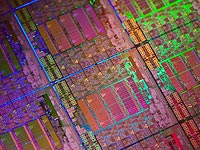When it comes to server efficiency, there are companies like Calxeda and SeaMicro — which was just acquired by AMD — that pack hundreds of low-power CPUs into servers that can handle massive workloads under relatively meager power requirements.
But what about the standard, run of the mill box?
It looks like Intel’s newest Xeons, the Sandy Bridge-based E5, has it covered in that regard. Sean Kerner over at ServerWatch writes:
The Xeon E5 also takes aim at making servers and the data centers they’re in, more efficient. According to Bryant, power consumption has been reduced by as much as 50 percent.
Enhanced power monitoring capabilities on the E5 track CPU utilization. As such, if a CPU is not being fully utilized, the processor can throttle back when not needed, which reduces overall power usage. Going a step further, the Intel Node Manager technology enables data center administrators to dynamically see what utilization is to help optimize and balance performance and power requirements.
Intel Node Manager is a neat concept. IT admins are long accustomed to metering processing, storage and network bandwidth. With this technology, they can take energy into account. And it goes beyond the processor.
According to Intel, “it limits power at the system, processor, and memory levels—utilizing policies defined by IT management.” For instance, this allows data center operators to keep their systems operating under certain, predetermined power thresholds, enabling them to deploy more servers before hitting the power ceiling.
Alternately, they can achieve energy savings by imposing low-power policies during periods of low utilization or when conditions threaten to trip a circuit breaker, so to speak. Cool!
As the maker of the vast majority of processor found in servers, it’s good to see Intel embrace energy management. It’s also a sign that Green IT is mainstream IT.


Leave a Reply